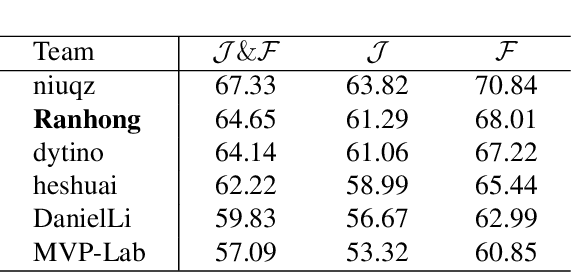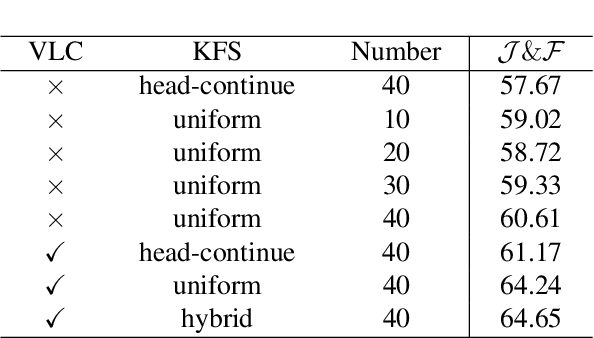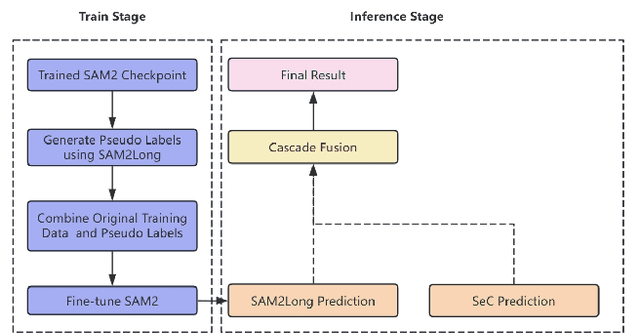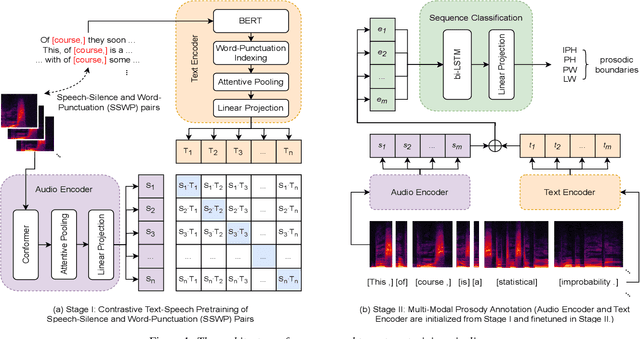Fengjie Zhu
Enhancing Sa2VA for Referent Video Object Segmentation: 2nd Solution for 7th LSVOS RVOS Track
Sep 19, 2025



Abstract:Referential Video Object Segmentation (RVOS) aims to segment all objects in a video that match a given natural language description, bridging the gap between vision and language understanding. Recent work, such as Sa2VA, combines Large Language Models (LLMs) with SAM~2, leveraging the strong video reasoning capability of LLMs to guide video segmentation. In this work, we present a training-free framework that substantially improves Sa2VA's performance on the RVOS task. Our method introduces two key components: (1) a Video-Language Checker that explicitly verifies whether the subject and action described in the query actually appear in the video, thereby reducing false positives; and (2) a Key-Frame Sampler that adaptively selects informative frames to better capture both early object appearances and long-range temporal context. Without any additional training, our approach achieves a J&F score of 64.14% on the MeViS test set, ranking 2nd place in the RVOS track of the 7th LSVOS Challenge at ICCV 2025.
Pseudo-Label Enhanced Cascaded Framework: 2nd Technical Report for LSVOS 2025 VOS Track
Sep 18, 2025



Abstract:Complex Video Object Segmentation (VOS) presents significant challenges in accurately segmenting objects across frames, especially in the presence of small and similar targets, frequent occlusions, rapid motion, and complex interactions. In this report, we present our solution for the LSVOS 2025 VOS Track based on the SAM2 framework. We adopt a pseudo-labeling strategy during training: a trained SAM2 checkpoint is deployed within the SAM2Long framework to generate pseudo labels for the MOSE test set, which are then combined with existing data for further training. For inference, the SAM2Long framework is employed to obtain our primary segmentation results, while an open-source SeC model runs in parallel to produce complementary predictions. A cascaded decision mechanism dynamically integrates outputs from both models, exploiting the temporal stability of SAM2Long and the concept-level robustness of SeC. Benefiting from pseudo-label training and cascaded multi-model inference, our approach achieves a J\&F score of 0.8616 on the MOSE test set -- +1.4 points over our SAM2Long baseline -- securing the 2nd place in the LSVOS 2025 VOS Track, and demonstrating strong robustness and accuracy in long, complex video segmentation scenarios.
Multi-Modal Automatic Prosody Annotation with Contrastive Pretraining of SSWP
Sep 11, 2023

Abstract:In the realm of expressive Text-to-Speech (TTS), explicit prosodic boundaries significantly advance the naturalness and controllability of synthesized speech. While human prosody annotation contributes a lot to the performance, it is a labor-intensive and time-consuming process, often resulting in inconsistent outcomes. Despite the availability of extensive supervised data, the current benchmark model still faces performance setbacks. To address this issue, a two-stage automatic annotation pipeline is novelly proposed in this paper. Specifically, in the first stage, we propose contrastive text-speech pretraining of Speech-Silence and Word-Punctuation (SSWP) pairs. The pretraining procedure hammers at enhancing the prosodic space extracted from joint text-speech space. In the second stage, we build a multi-modal prosody annotator, which consists of pretrained encoders, a straightforward yet effective text-speech feature fusion scheme, and a sequence classifier. Extensive experiments conclusively demonstrate that our proposed method excels at automatically generating prosody annotation and achieves state-of-the-art (SOTA) performance. Furthermore, our novel model has exhibited remarkable resilience when tested with varying amounts of data.
TranssionADD: A multi-frame reinforcement based sequence tagging model for audio deepfake detection
Jun 27, 2023Abstract:Thanks to recent advancements in end-to-end speech modeling technology, it has become increasingly feasible to imitate and clone a user`s voice. This leads to a significant challenge in differentiating between authentic and fabricated audio segments. To address the issue of user voice abuse and misuse, the second Audio Deepfake Detection Challenge (ADD 2023) aims to detect and analyze deepfake speech utterances. Specifically, Track 2, named the Manipulation Region Location (RL), aims to pinpoint the location of manipulated regions in audio, which can be present in both real and generated audio segments. We propose our novel TranssionADD system as a solution to the challenging problem of model robustness and audio segment outliers in the trace competition. Our system provides three unique contributions: 1) we adapt sequence tagging task for audio deepfake detection; 2) we improve model generalization by various data augmentation techniques; 3) we incorporate multi-frame detection (MFD) module to overcome limited representation provided by a single frame and use isolated-frame penalty (IFP) loss to handle outliers in segments. Our best submission achieved 2nd place in Track 2, demonstrating the effectiveness and robustness of our proposed system.
 Add to Chrome
Add to Chrome Add to Firefox
Add to Firefox Add to Edge
Add to Edge